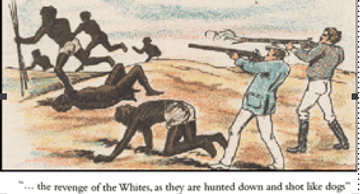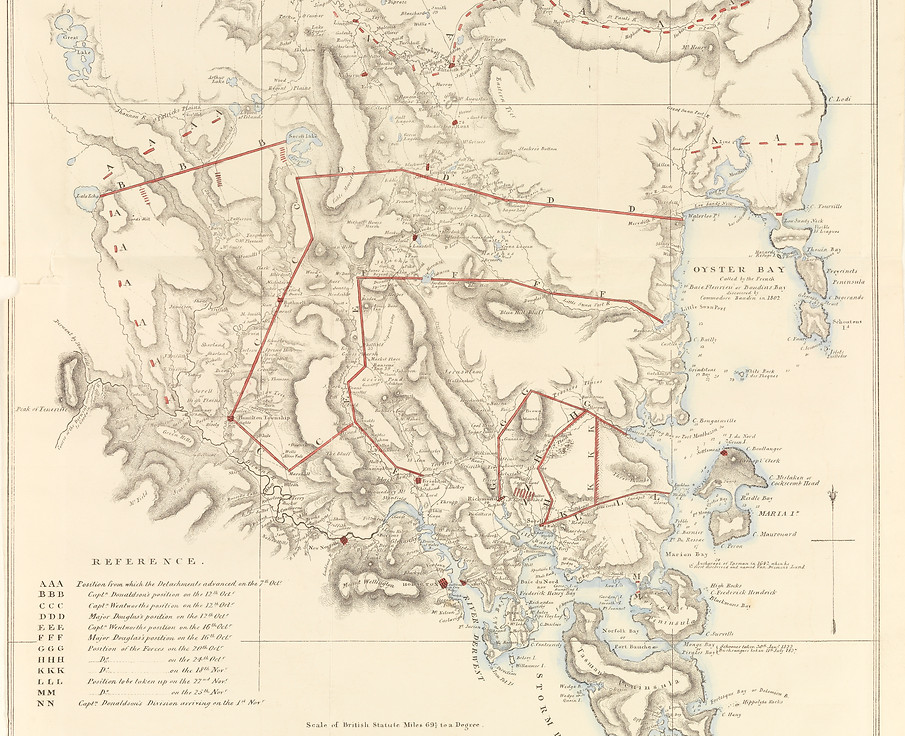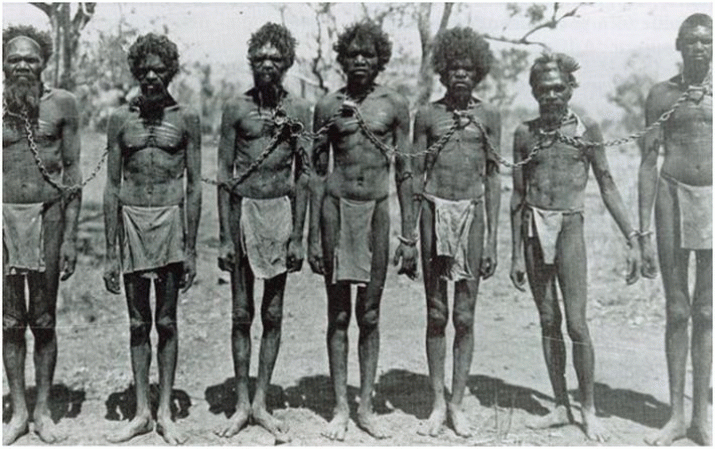top of page
This site may contain words, descriptions and images which may sadden and distress some Aboriginal and Torres Strait Islander people.
The Treatment of the Tasmanian Aborigines by the British
(Australian Journalist, John Pilger, 1985)
Youtube Clip: John Pilger - The Secret Country - The First Australians Fight Back [1985]
Desbcribes Tasmanian Genocide | Watch specifically [11:44 - 13:35]
Governor Arthur's Proclamation

Sir Governor Arthur’s 1828 Proclamation Board to the Aborigines (suggested by George Frankland as a visual tool to go with Arthur’s Proclamation)
“Whereas, at and since the primary Settlement of this Colony, various acts of aggression, violence and cruelty have been, from different causes, committed on the Aboriginal Inhabitants on the Island by Subjects of His Majesty”
(Lieutenant Governor of Van Diemans Land (1823-1837), Sir George Arthur, 1828)
In 1828, Governor George Arthur responded to the escalating violence between the British colonists and Tasmanian Aborigines by issuing a proclamation in The Hobart Town Courier. The text (see excerpt above) explains the reason behind the Proclamation Poster which was later produced and hung in various places for colonists and Aborigines to see. The Proclamation Poster (left) attempts the explain the idea of equality under the law at that time. It is unquestionably ironic due to the fact that just after it was created by the government, Arthur 'dismissed' this law himself, by ordering the movement and killing-of Tasmanian Aborigines.
The primarily systematic killing of the Tasmanian Aboriginal people by the British

An image which illustrates one of the ways the British killed the Aborigines in Tasmania during the Black War.
“Sometimes the black people were hunted just for fun, on foot or on horseback. Sometimes they were raped in passing, or abducted as mistresses or salves.”
(Historian James Morris, 1972)
“the indigenous islanders were deliberately targeted for ‘extirpation’, to use the words of the day, with the full approval of the British government. Furthermore, the violence against them was carried out by British men and reported..."
(Historian of Holocaust & Genocide, Tom Lawson, 2014)
Throughout the Black War, the colonial government allowed violence towards the Aboriginal people which resulted in their 'extermination'. This has come to be termed 'genocide'. While there were several ways in which the Tasmanian Aborigines were killed by the settlers, the most disturbing aspect of their killing was that "sometimes, the black people were hunted just for fun" (Morris, 1972). This indicates that the killing of Aborigines was seen as a form of entertainment. Evidence of a genocide is given by Lawson when he states "the indigenous islanders were deliberately targeted......with the full approval of the British government" (My emphasise, Lawson, 2014).

"To enforce the order, government-sponsored "patrol teams" composed of prisoners led by policemen were established. The “patrol teams” chased and killed Tasmanians as the soldiers had the authority to immediately kill any Tasman they found in the settled areas."
(The Combat Genocide Association, 2014)
The above quote clearly demonstrates the 'systematic killing' of the Tasmanian Aborigines by 'patrol teams' that were 'sponsored' by the colonial government during the Black War.
"the lieutenant governor, George Arthur, decided to segregate the Aborigines on the southeastern peninsula of the island. Several thousand settlers were formed into a Black Line to drive the Aborigines out of the bush."
(Encyclopeida Britannica, 2016)
The Black Line of 1830 was a campaign consisting of about 2200 men who formed a staggered front of more than 300km long that 'sought to drive the Aborigines out of the bush' (Encyclopedia Britannica, 2016). Furthermore, it sought to force them onto certain islands off the coast of Tasmania. The above map illustrates parts of the Black Line.
"The extermination of Tasmanian Aborigines involved five major techniques: the officially sanctioned seizure of the bulk of Aboriginal hunting grounds by a privileged elite of British invaders; abduction of women and children, which had a massive impact on Aborigines’ability to reproduce themselves; murder and massacre, usually but not always of men; from late 1826, a War of Extermination, encouraged and sanctioned by government and involving the repeated use of massacre; and from 1829 government-orchestrated capture, exile and incarceration of Aborigines in ‘establishments’ located on off-shore islands."
(Historian Shayne Breen, 2011)
Breen's words corroborate with the above sources by listing the 'major techniques' that were used in order to 'exterminate' the Tasmanian Aborigines. The major tragedy of the conflict that occurred in Tasmania was the attempted 'extermination' of the entire 'full-blooded' Tasmanian population. In order to kill the Aborigines, the British went to great lengths such as the 'abduction women and children' (Breen, 2001), which would ensure the eventual demise of the entire population.
Conditions under which the Tasmanian Aborigines had to live as a result of British occupation

(Historian Shayne Breen, 2011)
While the Black Line did not achieve its objectives, another initiative did. In 1829, the remaining Tasmanian Aborigines were taken to surrounding Tasmanian islands, the most well-known being Flinders Island. It was a man named George Augustus Robinson who was in charge of these establishments. He erroneously believed that their placement in separate areas would protect them. He also sought to teach them Christian ways. However, instead of helping the Aborigines he contributed to their downfall because being separated from their homelands they lost their sense of identity, their spirit and culture.

“they were not to be allowed to leave. The aim was the destruction of all aspects of indigenous culture and its replacement with settler sensibilities. This was how the benefits of colonization were to be shared. Today we would call this cultural genocide.”
(Historian of Holocaust and Genocide Tom Lawson, 2014)
"This 1840 painting idealised the work of George Augustus Robinson, who took up the post of 'Protector of Aborigines' in Van Diemen's Land on 27 January 1830. Benjamin Duterrau's The Conciliation was considered the first historical epic painting in the Australian colonies; it now marks the long path towards legal acknowledgment of Tasmanians of Indigenous descent" (Museum of Australian Democracy)
“Confinement in an artificial environment with inadequate shelter, a high-salt diet, a poor water supply, the separation of children from parents, and a program of re-education into Christian civilisation was a radical departure from the balanced diet, fresh water and the cultural autonomy characteristic of the hunter-gatherer lifestyle.”
(Historian, Shayne Breen, 2011)
Lawson and Breen are both historians who describe the cultural genocide that occurred in Tasmania as well as the 'extermination' of the Aborigines. As Lawson states, "the aim was the destruction of all aspects of indigenous culture" (Lawson, 2014), which was done by "separation of children from parents, and a program of re-education into Christian civilisation" (Breen, 2011). As mentioned previously, this was a significant aspect of the tragedy as not only was there an attempted extermination of a whole people but also a culture.
Truganini - The last Tasmanian of solely Aboringal Descendance

This is a photograph of Truganini, the last 'full-blooded' Tasmanian Aborigine. It is thought to be taken in 1866. Looking carefully at the Turganini's face, you can see the sadness and concern in her eyes. She wears European clothing.
“Truganini was terrified that, like King Billy before her, she would be exhumed and dissected after burial. “Don’t let them cut me up,” she pleaded on her death bed. ”
(Historian James Morris, 1972)
This quote from “The Final Solution Down Under” was written by historian James Morris. It reflects the fear that Truganini's fear of the fate or her body after her death. It highlights the lack of control that Tasmanian Aborigines had over their destinies.

Newspaper Article taken from 'The Mercury' [Friday, 18 April 1947]. This is tragedy on its own as the British could not even honour Truganin's wish. Her skeleton was displayed in a British museum.
bottom of page

